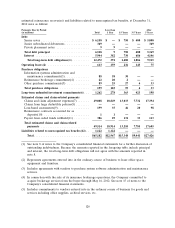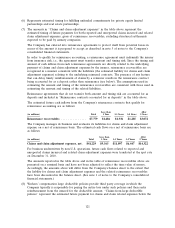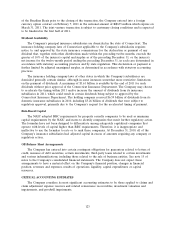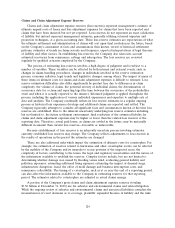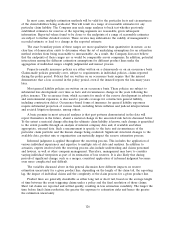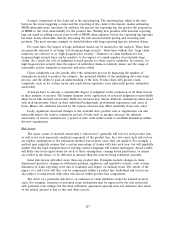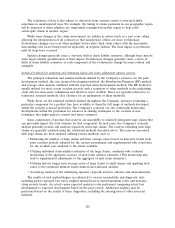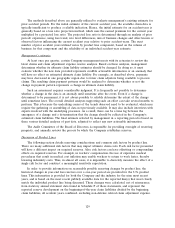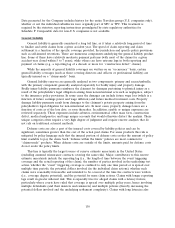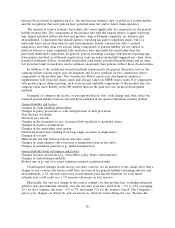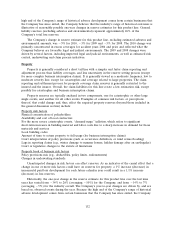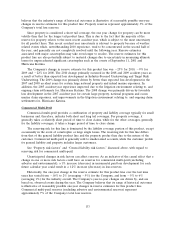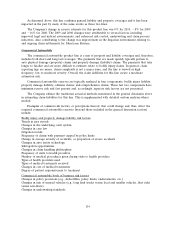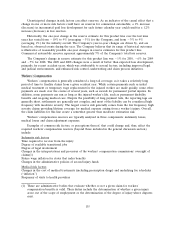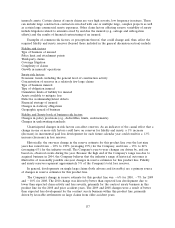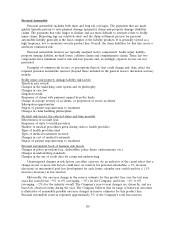Travelers 2010 Annual Report Download - page 142
Download and view the complete annual report
Please find page 142 of the 2010 Travelers annual report below. You can navigate through the pages in the report by either clicking on the pages listed below, or by using the keyword search tool below to find specific information within the annual report.
Data presented for the Company includes history for the entire Travelers group (U.S. companies only),
whether or not the individual subsidiaries were originally part of SPC or TPC. This treatment is
required by the statutory reporting instructions promulgated by state regulatory authorities for
Schedule P. Comparable data for non-U.S. companies is not available.
General Liability
General liability is generally considered a long tail line, as it takes a relatively long period of time
to finalize and settle claims from a given accident year. The speed of claim reporting and claim
settlement is a function of the specific coverage provided, the jurisdiction and specific policy provisions
such as self-insured retentions. There are numerous components underlying the general liability product
line. Some of these have relatively moderate payment patterns (with most of the claims for a given
accident year closed within 5 to 7 years), while others can have extreme lags in both reporting and
payment of claims (e.g., a reporting lag of a decade or more for ‘‘construction defect’’ claims).
While the majority of general liability coverages are written on an ‘‘occurrence’’ basis, certain
general liability coverages (such as those covering directors and officers or professional liability) are
typically insured on a ‘‘claims-made’’ basis.
General liability reserves are generally analyzed as two components: primary and excess/umbrella,
with the primary component generally analyzed separately for bodily injury and property damage.
Bodily injury liability payments reimburse the claimant for damages pertaining to physical injury as a
result of the policyholder’s legal obligation arising from non-intentional acts such as negligence, subject
to the insurance policy provisions. In some cases the damages can include future wage loss (which is a
function of future earnings power and wage inflation) and future medical treatment costs. Property
damage liability payments result from damages to the claimant’s private property arising from the
policyholder’s legal obligation for non-intentional acts. In most cases, property damage losses are a
function of costs as of the loss date, or soon thereafter. In addition, sizable or unique exposures are
reviewed separately. These exposures include asbestos, environmental, other mass torts, construction
defect, medical malpractice and large unique accounts that would otherwise distort the analysis. These
unique categories often require a very high degree of judgment and require reserve analyses that do
not rely on traditional actuarial methods.
Defense costs are also a part of the insured costs covered by liability policies and can be
significant, sometimes greater than the cost of the actual paid claims. For some products this risk is
mitigated by policy language such that the insured portion of defense costs erodes the amount of policy
limit available to pay the claim. Such ‘‘defense within the limits’’ policies are most common for
‘‘claims-made’’ products. When defense costs are outside of the limits, amounts paid for defense costs
do not erode the policy limits.
This line is typically the largest source of reserve estimate uncertainty in the United States
(excluding assumed reinsurance contracts covering the same risk). Major contributors to this reserve
estimate uncertainty include the reporting lag (i.e., the length of time between the event triggering
coverage and the actual reporting of the claim), the number of parties involved in the underlying tort
action, whether the ‘‘event’’ triggering coverage is confined to only one time period or is spread over
multiple time periods, the potential dollars involved (in the individual claim actions), whether such
claims were reasonably foreseeable and intended to be covered at the time the contracts were written
(i.e., coverage dispute potential), and the potential for mass claim actions. Claims with longer reporting
lags result in greater inherent risk. This is especially true for alleged claims with a latency feature,
particularly where courts have ruled that coverage is spread over multiple policy years, hence involving
multiple defendants (and their insurers and reinsurers) and multiple policies (thereby increasing the
potential dollars involved and the underlying settlement complexity). Claims with long latencies also
130


